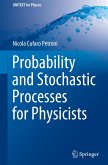Stochastic processes are an essential part of numerous branches of physics, as well as in biology, chemistry, and finance. This textbook provides a solid understanding of stochastic processes and stochastic calculus in physics, without the need for measure theory. In avoiding measure theory, this textbook gives readers the tools necessary to use stochastic methods in research with a minimum of mathematical background. Coverage of the more exotic Levy processes is included, as is a concise account of numerical methods for simulating stochastic systems driven by Gaussian noise. The book concludes with a non-technical introduction to the concepts and jargon of measure-theoretic probability theory. With over 70 exercises, this textbook is an easily accessible introduction to stochastic processes and their applications, as well as methods for numerical simulation, for graduate students and researchers in physics.








